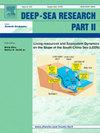罗斯海水文和生物地球化学变量的季节模式:BGC-Argo分析
IF 3
3区 地球科学
Q2 OCEANOGRAPHY
Deep-sea Research Part Ii-topical Studies in Oceanography
Pub Date : 2025-02-01
DOI:10.1016/j.dsr2.2024.105436
引用次数: 0
摘要
季节性冻结水域的季节模式通常是由不同年份进行的综合分析得出的,而且主要局限于无冰期。本文首次对罗斯海大陆架上的生物地球化学-阿尔戈(BGC-Argo)剖面浮标收集的一整年的水文和生物地球化学变量进行了连续测量。分析分为秋季/冬季和春季/夏季两个阶段。混合层在冰盖上迅速增加,硝酸盐、氧和溶解无机碳的垂直分布受这种深层混合的强烈影响。秋季的硝化速率是可观的,与在海洋其他地区测量到的速率相似。有机碳的消失也在3月份最为迅速。5月之后,所有变量的变化都明显放缓。最大的混合层深度出现在南部浮标,达到400-500 m。春季/夏季的模式与个体游船期间观察到的相似,硝酸盐的快速清除从11月开始,持续到1月初,但在南部夏季停止。叶绿素最迅速的积累发生在冰完全消退之前。显著的空间差异可能与混合层深度和浮游植物组成有关。颗粒物质在整个夏季都在100米以下积聚,尽管变化的速度表明水柱中存在大量的再矿化。观测到的时间模式表明,相对较短的周期对生物地球化学参数的垂直分布有显著影响。本文章由计算机程序翻译,如有差异,请以英文原文为准。
The seasonal patterns of hydrographic and biogeochemical variables in the Ross Sea: A BGC-Argo analysis
Seasonal patterns in seasonally frozen waters have usually been derived from composites of analyses conducted in different years and largely have been confined to ice-free periods. We present the first continuous measurements of hydrographic and biogeochemical variables collected over an entire year by Biogeochemical-Argo (BGC-Argo) profiling floats on the continental shelf of the Ross Sea. Analyses were divided into two periods: autumn/winter and spring/summer. Mixed layers increased rapidly upon ice cover, and nitrate, oxygen, and dissolved inorganic carbon vertical distributions were strongly influenced by this deeper mixing. Rates of nitrification in autumn were substantial and similar to rates measured in other areas of the ocean. Organic carbon disappearance was also most rapid in March. Changes in all variables slowed considerably after May. The largest mixed layer depths occurred at the southern floats and reached 400–500 m. Spring/summer patterns were similar to those observed during individual cruises, with rapid nitrate removal beginning in November, continuing through early January, but ceasing during austral summer. The most rapid accumulations of chlorophyll occurred prior to complete ice retreat. Substantial spatial differences were noted that were likely related to both mixed layer depths and phytoplankton composition. Particulate matter accumulated throughout the summer below 100 m, although the rates of change suggested substantial remineralization in the water column. The temporal patterns observed show the importance of relatively short periods that markedly influence the vertical distribution of biogeochemical parameters.
求助全文
通过发布文献求助,成功后即可免费获取论文全文。
去求助
来源期刊
CiteScore
6.40
自引率
16.70%
发文量
115
审稿时长
3 months
期刊介绍:
Deep-Sea Research Part II: Topical Studies in Oceanography publishes topical issues from the many international and interdisciplinary projects which are undertaken in oceanography. Besides these special issues from projects, the journal publishes collections of papers presented at conferences. The special issues regularly have electronic annexes of non-text material (numerical data, images, images, video, etc.) which are published with the special issues in ScienceDirect. Deep-Sea Research Part II was split off as a separate journal devoted to topical issues in 1993. Its companion journal Deep-Sea Research Part I: Oceanographic Research Papers, publishes the regular research papers in this area.

 求助内容:
求助内容: 应助结果提醒方式:
应助结果提醒方式:


